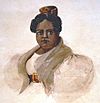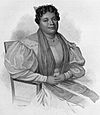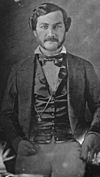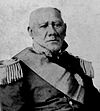Kuhina Nui facts for kids
Quick facts for kids Kuhina Nui of Hawaii |
|
|---|---|

Flag of the Kuhina Nui
|
|
| Style | His/Her Highness |
| Appointer | King(s) of Hawaii |
| Precursor | none |
| Formation | 1819 |
| First holder | Kaʻahumanu I |
| Final holder | Mataio Kekūanāoʻa |
| Abolished | 1864 |
| Succession | none |
The Kuhina Nui was a very important job in the Kingdom of Hawaiʻi. This powerful position existed from 1819 to 1864. Usually, a family member of the king held this role. You can think of it like a Prime Minister or a Regent (someone who rules when the king is too young).
Contents
How the Kuhina Nui Job Started
Before the Kuhina Nui job was created, there was an older position called Kālaimoku. This job had been around since the very beginning of Hawaiian history. The Kālaimoku was like a trusted advisor to the king.
When King Kamehameha II became king in 1819, his father's favorite wife, Queen Kaʻahumanu, told him something important. She said that Kamehameha I (Kamehameha II's father) wanted her to rule the kingdom alongside his son. We don't know for sure if this was true. But Kamehameha II agreed, and so the job of Kuhina Nui was created just for Kaʻahumanu.
Kaʻahumanu became a very strong leader in the kingdom. She, along with Kamehameha II's mother, Keōpūolani, convinced the young king to get rid of the old kapu system. The kapu system was a set of strict laws and religious rules.
Power Struggles: Kuhina Nui vs. King
When Kamehameha II died in 1824, his younger brother, Kauikeaouli, was still a child. Because of this, Kaʻahumanu ruled in his place as a regent. A regent is someone who governs a country when the king or queen is too young or unable to rule.
After Kaʻahumanu died in 1832, another queen named Kīnaʻu took over as Kuhina Nui. She was a daughter of Kamehameha I. Kīnaʻu also acted as regent until Kauikeaouli became old enough to rule in 1833. After he was crowned King Kamehameha III, the Kuhina Nui became the second most powerful job in the kingdom.
During Kīnaʻu's time as Kuhina Nui, she and King Kamehameha III often disagreed. Kamehameha III wanted to bring back some of the old Hawaiian culture. But Kīnaʻu wanted Hawaiʻi to be a Protestant Christian state. She did not want other religions to be allowed. These disagreements caused problems for the kingdom for several years.
The 1840 Constitution and the Kuhina Nui
In 1840, the Kingdom of Hawaiʻi wrote its first constitution. This important document officially made the Kuhina Nui job a part of the law. The constitution explained the Kuhina Nui's duties and powers:
- The king would choose the Kuhina Nui.
- The Kuhina Nui would handle all important kingdom business for the king.
- Any document signed by the Kuhina Nui was considered approved by the king.
- All government property had to be reported to the Kuhina Nui.
- Neither the king nor the Kuhina Nui could make big decisions without the other knowing.
- If the king wanted to handle important business himself, he needed the Kuhina Nui's approval.
The 1840 Constitution made sure the king and Kuhina Nui shared power. Both had seats in the House of Nobles (part of the government) and in the kingdom's courts.
It's interesting that American advisors helped write this constitution. In the United States at that time, women could not hold political jobs or even vote. But these Americans believed it was right to give the Kuhina Nui, who was usually a woman, as much power as the king.
The 1852 Constitution and the Kuhina Nui
The 1852 Constitution of the Kingdom of Hawaiʻi had a whole section just for the Kuhina Nui. It described the job in more detail:
- The Kuhina Nui was given the official title, "Kuhina Nui of the Hawaiian Islands." They were also called "Highness."
- The Kuhina Nui would handle all important kingdom business for the king.
- Any document signed by the Kuhina Nui was considered approved by the king.
- If the king wanted to handle important business himself, he needed the Kuhina Nui's approval.
- The Kuhina Nui would act as regent if the king was away or too young to rule. If there was no king, the Kuhina Nui would rule until a new king was chosen.
The End of the Kuhina Nui Job
The way power was shared between the king and Kuhina Nui seemed to work well for a while. It continued through the reigns of Kamehameha III and Kamehameha IV. Kamehameha IV and his brother didn't like the Kuhina Nui position much. But Kamehameha IV still gave the role to his sister, Victoria Kamamalu. She mostly just signed papers that her brothers wanted.
However, when Kamehameha V became king in 1863, he wanted more power for himself. He preferred an autocratic monarchy (where the king has almost all the power) instead of the constitutional one (where power is shared) that was set up in 1852.
In 1864, King Kamehameha V created a new constitution. This 1864 Constitution was much less liberal. It got rid of the Kuhina Nui job completely. The king took all of the Kuhina Nui's powers for himself. The job was never brought back. The Hawaiian monarchy lasted for about 30 more years after that before it was overthrown.
List of Kuhina Nui
Female Kuhina Nui often took the name "Kaʻahumanu" followed by a number. This was to honor Queen Kaʻahumanu, who was the very first person to hold the job. It was similar to how all members of the Kamehameha royal family took the name "Kamehameha."
| Portrait | Name | Born–Died | Took Office | Left office |
|---|---|---|---|---|
| Kaʻahumanu I | 1768–1832 | 1819 | June 5, 1832 | |
 |
Kaʻahumanu II | 1805–1839 | June 5, 1832 | April 4, 1839 |
 |
Kaʻahumanu III | 1794–1845 | April 5, 1839 | June 7, 1845 |
 |
Keoni Ana | 1810–1857 | June 10, 1845 | January 16, 1855 |
 |
Kaʻahumanu IV | 1838–1866 | January 16, 1855 | December 21, 1863 |
 |
Mataio Kekūanāoʻa | 1793–1868 | December 21, 1863 | August 24, 1864 |

